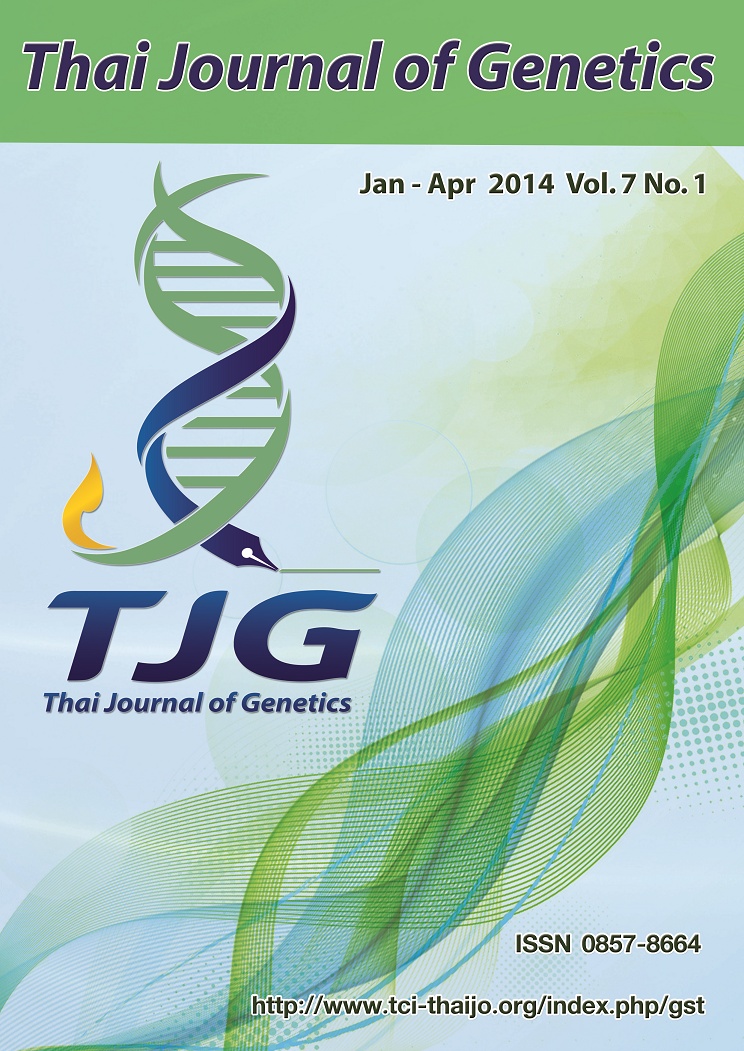A genetic screen of chitosan-resistant mutant in Arabidopsis thaliana
DOI:
https://doi.org/10.14456/tjg.2014.8Keywords:
chitosan, mutantAbstract
Forward genetic approach is a powerful tool to elucidate plant response to elicitors. Chitosan, the biodegradable polymer deacetylated form of chitin, plays a role as an elicitor in many plants. To discover the chitosan response mechanism, we achieved a screening for the EMS-mutagenized Arabidopsis population with chitosan-resistant characters that has not been previously reported. At the seedling stage, high dosage of chitosan reduced plant growth both shoot and root systems. Mutant phenotype is characterized by the larger plant size and/or longer root length compared with wild-type plant on 80 mg/L chitosan supplemented plates. Mutants also showed leaf defect phenotypes such as leaf shape and leaf coloration. A number of the putative mutants were sterile, with no flowers or showed early senescence before completion of their life cycles. At least 5 chitosan-insensitive mutant lines showed the larger shoots or longer root length comparing to wild type in chitosan treated condition. The genetic inheritance analysis with Ler background crosses showed heterosis phenotype, interfering the growth-related trait of chitosan-resistant characters. To avoid the heterosis interference, the mutants were crossed with Col background. To identify the mutant population with a single recessive mutated gene, F2 progeny of each cross was evaluated. Only three mutant lines, 106A, 129A and 161A showed the potential to contain the single recessive mutated genes involving in chitosan response. However, the 129A line did not showed the consistent chitosan-insensitive phenotype after the repeated phenotyping of the M3 population. Therefore, only 106A and 161A will be used for further chitosan-responsive gene characterization as the next step.
References
Abdelbasset EH, Lorne RA, Ismail EH and Fouad D (2010) Chitosan in plant protection. Mar Drugs 8: 968–987.
Asghari-Zakaria R, Maleki-Zanjani B and Sedghi E (2009) Effect of in vitro chitosan application on growth and minituber yield of Solanum tuberosum L. Plant soil environ 55: 252–256.
Berná G, Robles P and Micol JL (1999) A mutational analysis of leaf morphogenesis in Arabidopsis thaliana. Genetics 152: 729–742.
Budziszewski GJ, Lewis SP, Glover LW, Reineke J, Jones G, Ziemnik LS, Lonowski J, Nyfeler B, Aux G, Zhou Q, McElver J, Patton DA, Martienssen R, Grossniklaus U, Ma H, Law M and Levin JZ (2001) Arabidopsis genes essential for seedling viability: Isolation of insertional mutants and molecular cloning. Genetics 159: 1765–1778.
Ferri M and Tassoni A (2011) Chitosan as elicitor of health beneficial secondary metabolites in in vitro plant cell cultures. In: Mackay RG and Tait JM (eds) Handbook of Chitosan Research and Applications. Nova Science Publishers, New York, pp 389–414.
Guan Y-J, Hu J, Wang X-J and Shao C-X (2009) Seed priming with chitosan improves maize germination and seedling growth in relation to physiological changes under low temperature stress. J Zhejiang Univ Sci B 10: 427–433.
Jurgens G, Mayer U, Torres Ruiz RA, Berleth T and Misera S. (1991) Genetic analysis of pattern formation in the Arabidopsis embryo. Development 91: 27–38.
Kim Y, Schumaker KS and Zhu J-K (2006) EMS mutagenesis of Arabidopsis. In: Arabidopsis Protocols. Springer, pp 101–103.
Koornneef M and Scheres B (2001) Arabidopsis thaliana as an Experimental Organism. In: eLS. John Wiley & Sons, Ltd., pp 1–6.
Kubasek WL, Shirley BW, McKillop A, Goodman HM, Briggs W and Ausubel FM (1992) Regulation of flavanoid biosynthetic genes in germinating Arabidopsis seedlings. Plant Cell 4: 1229–1236.
Page DR and Grossniklaus U (2002) The art and design of genetic screens: Arabidopsis thaliana. Nat Rev Genet 3: 124–136.
Pongprayoon W, Roytrakul S, Pichayangkura R and Chadchawan S (2013) The role of hydrogen peroxide in chitosan-induced resistance to osmotic stress in rice (Oryza sativa L.). Plant Growth Regul 70: 159–173.
Pornpienpakdee P, Singhasurasak R, Chaiyasap P, Pichyangkura R, Bunjongrat R, Chadchawan S and Limpanavech P (2010) Improving the micropropagation efficiency of hybrid Dendrobium orchids with chitosan. Sci Hort 124: 490–499.
Povero G, Loreti E, Pucciariello C, Santaniello A, Di Tommaso D, Di Tommaso G, Kapetis D, Zolezzi F, Piaggesi A and Perata P (2011) Transcript profiling of chitosan-treated Arabidopsis seedlings. J Plant Res 124: 619–629.
Syed NH and Chen ZJ. (2005) Molecular marker genotypes, heterozygosity and genetic interactions explain heterosis in Arabidopsis thaliana. Heredity (Edinb) 94: 295–304.
Vidhyasekaran P (2014) PAMP Signaling in Plant Innate Immunity. In: PAMP Signals in Plant Innate Immunity, vol 21. Signaling and Communication in Plants. Springer Netherlands, pp 17–161.
Yin H, Li S, Zhao X, Du Y and Ma X (2006) cDNA microarray analysis of gene expression in Brassica napus treated with oligochitosan elicitor. Plant Physiol Biochem 44: 910–916.



